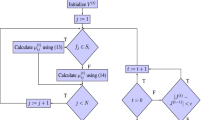Abstract
Rooted at the exponential possibility model recently developed by Tanaka and his colleagues, a new clustering criterion or concept is introduced and a possibility theoretic clustering algorithm is proposed. The new algorithm is characterized by a novel formulation and is distinctive in determining an appropriate number of clusters for a given dataset while obtaining a quality clustering result. The proposed algorithm can be easily implemented using an alternative minimization iterative procedure and its parameters can be effectively initialized by the Parzen window technique and Yager’s probability–possibility transformation. Our experimental results demonstrate its success in artificial datasets and large image segmentation. In order to reduce the complexity of large image segmentation, we propose to integrate the new clustering algorithm with a biased sampling procedure based on Epanechnikov kernel functions. As demonstrated by the preliminary experimental results, the possibility theoretic clustering is effective in image segmentation and its integration with a biased sampling procedure offers an attractive framework of large image processing.
Similar content being viewed by others
References
Aggrawal R, Gehrke J, Gunopulos D, Raghavan P (1998) Automatic subspace clustering of high dimensional data for data mining applications. In: Proceedings of 1998 ACM SIGMOD International Conference Management of Data, Seattle, Washington, pp 94–105
Bezdek JC. (1981) Pattern recognition with fuzzy objective function algorithm. Plenum, New York
Chung FL, Lee T (1994) Fuzzy competitive learning. Neural Netw 7(3):539–552
Cressie N (1993) Statistics for spatial data. Wiley, New York
Ester M, Kriegel HP, Sander J, Xu X. (1996) A density based algorithm for discovering clusters in large spatial databases with noise. Proceedings of International Conference Knowledge Discovery and Databases, pp 226–231
Gentile C (2003) The robustness of the p-norm algorithms. Mach Learn 53:265–299
Gokcay E, Principe JC (2002) Information theoretic clustering. IEEE Trans Pattern Anal Mach Intell 24(2):158–171
Guo P (2001) Exponential possibilistic data analysis for operations research. Ph.D. thesis (Osaka Prefecture University)
Guo P, Tanaka H (2001) Fuzzy DEA: A perceptual evaluation method. Fuzzy Sets Syst 119(1):149–160
Jacas J, Recasons J The group of isometries of an indistinguishability operator. Fuzzy Sets Syst (to appear)
Kollios G, Gunopulos D, Koudas N, et al. (2003) Efficient biased sampling for approximate clustering and outlier detection in large data sets. IEEE Trans Knowledge Data Eng 15(5):1170–1187
Krishnapuram R, Keller J (1993) A possibilistic approach to clustering. IEEE Trans Fuzzy Syst 1(2):98–110
Krishnapuram R, Keller J (1996) The possibilistic c-means algorithm: Insights and recommendations. IEEE Trans Fuzzy Syst 4(3):385–393
Krishnapuram R, Frigui H, Nasraoui O (1995) Fuzzy and possibilistic shell clustering algorithms and their application to boundary detection and surface approximation–Part I. IEEE Trans Fuzzy Syst 3(1):29–43
Krishnapuram R, Frigui H, Nasraoui O (1995) Fuzzy and possibilistic shell clustering algorithms and their application to boundary detection and surface approximation–Part II. IEEE Trans Fuzzy Syst 3(1):44–60
Masulli F, Rovetta S (2002) Soft transition from probabilistic to possibilistic fuzzy clustering. DISI Technical Report No. DISI-TR-02–03, Italy
Medasani S, Krishnapuram R (1994) Image thresholding via possibilistic clustering. Proceedings of NAFIPS/IFIS/NASA’94, pp.423–426,
Pal NR, Bezdek JC (2002) Complexity reduction for “large image” processing. IEEE Trans on Systems, Man and Cybernetics–Part B. Cybernetics, 32(5):598–611
Rosenfeld A, Kak AC (1982) Digital picture processing. Academic, New York
Scott D (1992) Multivariate density estimation: theory, practice and visualization. Wiley, New York
Sugihara K, Tanaka H (2001) Interval evaluations in the analytic hierarchy process by possibility analysis. Comput Intell 17(3):567–579
Tanaka H, Guo P (1999) Possibilistic data analysis for operations research. Physica-Verlag, New York
Tanaka H, Ishibuchi H (1993) Evidence theory of exponential possibility distributions. Int J Approximate Reasoning 8:123–140
Wang ST (1998) Fuzzy systems, fuzzy neural networks and their programming. Press of Shanghai Sci and Tech.
Wand MP, Jones MC (1995) Kernel smoothing. Chapman and Hall, New York
Wang ST, Jiang H, Lu HJ (2002) A new integrated clustering algorithm GFC and switching regressions. Pattern Recognit Artif Intell 16(4):433–447
Wang ST et al (2004) Gene selection for cancer classification using the new classification algorithm. Chinese J Bioinformatics 4(3):65–77
Wang ST et al (2004) Robust maximum entropy clustering algorithm RMEC and its labeling for outliers. Eng Sci China 6(3):70–83
Wang ST, Chung FL, Shen HB, Zhu RQ (2004) Note on the relationship between probabilistic and fuzzy clustering. Int J Soft Comput 8(5):366–369
Yager RR (2002) On the instantiation of possibility distributions. Fuzzy Sets Syst 128:261–266
Yan P et al. (2001) Neurocomputation and evolutionary strategies. Press of Tsinghua University
Zadeh LA (1978) Fuzzy sets as a basis for a theory of possibility. Fuzzy Sets Syst 1:3–28
Author information
Authors and Affiliations
Corresponding author
Rights and permissions
About this article
Cite this article
Chung, Fl., Wang, S., Xu, M. et al. Possibility Theoretic Clustering and its Preliminary Application to Large Image Segmentation. Soft Comput 11, 103–113 (2007). https://doi.org/10.1007/s00500-006-0056-8
Published:
Issue Date:
DOI: https://doi.org/10.1007/s00500-006-0056-8




